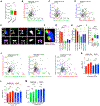Nanoscale Subsynaptic Domains Underlie the Organization of the Inhibitory Synapse
- PMID: 30893601
- PMCID: PMC6529211
- DOI: 10.1016/j.celrep.2019.02.070
Nanoscale Subsynaptic Domains Underlie the Organization of the Inhibitory Synapse
Abstract
Inhibitory synapses mediate the majority of synaptic inhibition in the brain, thereby controlling neuronal excitability, firing, and plasticity. Although essential for neuronal function, the central question of how these synapses are organized at the subsynaptic level remains unanswered. Here, we use three-dimensional (3D) super-resolution microscopy to image key components of the inhibitory postsynaptic domain and presynaptic terminal, revealing that inhibitory synapses are organized into nanoscale subsynaptic domains (SSDs) of the gephyrin scaffold, GABAARs and the active-zone protein Rab3-interacting molecule (RIM). Gephyrin SSDs cluster GABAAR SSDs, demonstrating nanoscale architectural interdependence between scaffold and receptor. GABAAR SSDs strongly associate with active-zone RIM SSDs, indicating an important role for GABAAR nanoscale organization near sites of GABA release. Finally, we find that in response to elevated activity, synapse growth is mediated by an increase in the number of postsynaptic SSDs, suggesting a modular mechanism for increasing inhibitory synaptic strength.
Keywords: GABA(A) receptor; RIM; VGAT; gephyrin; homeostatic plasticity; inhibitory synapse; structured illumination microscopy; super-resolution nanoscopy.
Copyright © 2019 The Author(s). Published by Elsevier Inc. All rights reserved.
Conflict of interest statement
DECLARATION OF INTERESTS
The authors declare no competing interests.
Figures






Similar articles
-
Subsynaptic Domains in Super-Resolution Microscopy: The Treachery of Images.Front Mol Neurosci. 2019 Jul 2;12:161. doi: 10.3389/fnmol.2019.00161. eCollection 2019. Front Mol Neurosci. 2019. PMID: 31312120 Free PMC article. Review.
-
Complementary Use of Super-Resolution Imaging Modalities to Study the Nanoscale Architecture of Inhibitory Synapses.Front Synaptic Neurosci. 2022 Apr 8;14:852227. doi: 10.3389/fnsyn.2022.852227. eCollection 2022. Front Synaptic Neurosci. 2022. PMID: 35463850 Free PMC article.
-
Stepwise disassembly of GABAergic synapses during pathogenic excitotoxicity.Cell Rep. 2021 Dec 21;37(12):110142. doi: 10.1016/j.celrep.2021.110142. Cell Rep. 2021. PMID: 34936876 Free PMC article.
-
Gephyrin promotes autonomous assembly and synaptic localization of GABAergic postsynaptic components without presynaptic GABA release.Proc Natl Acad Sci U S A. 2024 Jun 25;121(26):e2315100121. doi: 10.1073/pnas.2315100121. Epub 2024 Jun 18. Proc Natl Acad Sci U S A. 2024. PMID: 38889143 Free PMC article.
-
Postsynaptic plasticity of GABAergic synapses.Neuropharmacology. 2020 Jun 1;169:107643. doi: 10.1016/j.neuropharm.2019.05.020. Epub 2019 May 17. Neuropharmacology. 2020. PMID: 31108109 Review.
Cited by
-
A DARPin-based molecular toolset to probe gephyrin and inhibitory synapse biology.Elife. 2022 Oct 31;11:e80895. doi: 10.7554/eLife.80895. Elife. 2022. PMID: 36314779 Free PMC article.
-
Tuning GABAergic Inhibition: Gephyrin Molecular Organization and Functions.Neuroscience. 2020 Jul 15;439:125-136. doi: 10.1016/j.neuroscience.2019.07.036. Epub 2019 Jul 26. Neuroscience. 2020. PMID: 31356900 Free PMC article. Review.
-
Nano-organization of spontaneous GABAergic transmission directs its autonomous function in neuronal signaling.Cell Rep. 2022 Aug 9;40(6):111172. doi: 10.1016/j.celrep.2022.111172. Cell Rep. 2022. PMID: 35947950 Free PMC article.
-
Excitatory and inhibitory receptors utilize distinct post- and trans-synaptic mechanisms in vivo.Elife. 2021 Oct 18;10:e59613. doi: 10.7554/eLife.59613. Elife. 2021. PMID: 34658339 Free PMC article.
-
Subsynaptic Domains in Super-Resolution Microscopy: The Treachery of Images.Front Mol Neurosci. 2019 Jul 2;12:161. doi: 10.3389/fnmol.2019.00161. eCollection 2019. Front Mol Neurosci. 2019. PMID: 31312120 Free PMC article. Review.
References
Publication types
MeSH terms
Substances
Grants and funding
LinkOut - more resources
Full Text Sources
Research Materials

